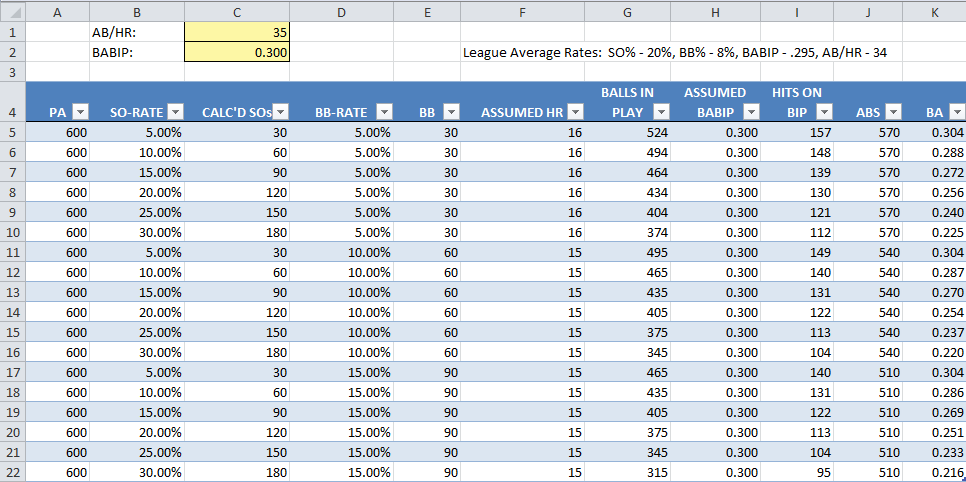Read any fantasy baseball analysis and you’re bound to encounter the hitter strikeout rate (or K-percentage) statistic. “Player A’s strikeout rate has increased from 18% last year to 22% so far this year”. I understand K-percentage is, it’s not complicated to calculate. But I’ve never been able to locate a good explanation of why strikeout rate is inherently bad or what it indicates. So I set out to answer some of these questions.
My goal in this post is to take a deep look into what strikeout rate is and what effect it has on batting average. If you’re not much for reading, skip to the spreadsheet illustrating the effect of strikeout rate on batting average.
What Is Strikeout Rate?
This is simply the percentage of plate appearances that result in a strikeout. Fangraphs has a good, brief discussion of the statistic and what represents an Awful-to-Excellent rate.
Strikeout Rate = Strikeouts / Plate Appearances
What Does This Mean? Why Do We Care?
After quite a bit of scouring the internet, I am still unable to locate anything more than the basic definition of the term strikeout rate (if you know of a great explanation, please leave a comment or Tweet me the link). The Fangraphs article mentions the more a player strikes out, the more difficult it is to maintain a high batting average, but it’s short on specifics. I found a nice article at Beyond the Box Score about how to predict strikeout rate. But that seems like a pointless exercise until I understand more about the statistic (why predict something I don’t fully understand!).
Since I can’t find a great resource, I’m left to speculate and make an educated guess. It’s pretty clear that a strikeout is a missed opportunity to put the ball in play. It’s certainly an out. So it inherently is detrimental to a players batting average (the ball is not put into play, so the AB cannot result in a hit). Further, it can’t lead to a run, HR, or RBI.
While we know it’s bad for batting average, it’s very important to keep in mind that there is also a trade off. Watch enough baseball and you know that striking out is related to power. And it’s been proven that this is the case. So we know that striking out negatively affects batting average, but it is positively related to hitting for power. Meaning there’s likely some point at which you could optimize a hitters ability to hit for average and still hit for power. That seems like a different article for a different day.
The Effect On Batting Average
How much does strikeout rate affect batting average? I created a spreadsheet to answer this question. There is an image of the spreadsheet below. You can also access it using this link.
For the illustration, I assumed a full-time player (600 plate appearances). Batting average is also going to be affected by the player’s walk rate, in the sense that players with higher walk rates have less at bats during the year (at bats are the denominator in the batting average equation). To account for this, the table shows different batting average calculations for each of a 5%, 10%, and 15% walk rate.
BABIP is another significant factor in batting average, so I added the ability to adjust BABIP in yellow drop down box at the top. BABIP excludes home runs in its calculation, so I allowed for a home run adjustment too.

Findings
Focus just on the 5% BB rate portion of the table (league average is 8%, so this is a fair approximation of league average). Everything else held constant (BB rate, HR rate, and BABIP), going from a 5% strikeout rate to a 10% rate results in a .016 drop in batting average. And that appears to hold true throughout the entire table.
All other factors held constant, a 5% increase in strikeout rate will results in roughly a 16 to 18 point drop in batting average.
Applying This
To this point in the 2013 season, Chris Davis has decreased his strikeout rate 4% from his career average (30.2% to 26.1% according to baseball-reference.com). So from just that change alone we can expect somewhere around a 12-15 point jump in batting average. Throw in a ridiculous HR/AB rate and you have another huge jump in batting average.
You could also use this as a quick method of valuing one player in relation to another from a batting average perspective. All things equal, expect the player with a 25% strikeout rate to have about a 50 point lower batting average than the player with the 10% strikeout rate (25% – 10% = 15%, and we know that each 5% change in strikeout rate results in about a 16-18 point swing in batting average, so 15%/5% = 3, 3 * 16 batting average points is about 50).
Please Do Me a Favor
If you’ve found this article insightful, please follow me on Twitter!
Follow @smartfantasybb
Thanks for visiting the site. Make smart choices.
Additional Resources About Strikeout Rate
- How Many Strikeouts is too Many by Jeff Sackmann at The Hardball Times
- WHIFF! Strikeout Rates Explained by Blake Murphy at Beyond the Box Score
- What Do minor League Walk and Strikeout Rates Tell Us About Prospects by Chris St. John at Platoon Advantage







You made a critical typo. You just finished writing about Chris Davis gaining batting average after reducing his strikeout rate, then you drop this gem: “All things equal, expect the player with a 25% strikeout rate to have about a 50 point higher batting average than the player with the 10% strikeout rate.”
You had one job.
Thanks, Jerry. I corrected this typo.